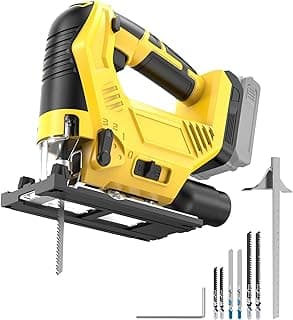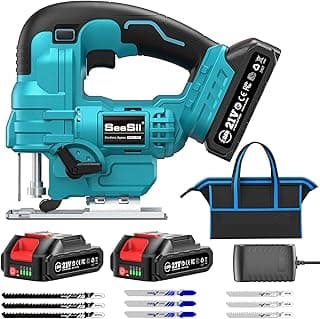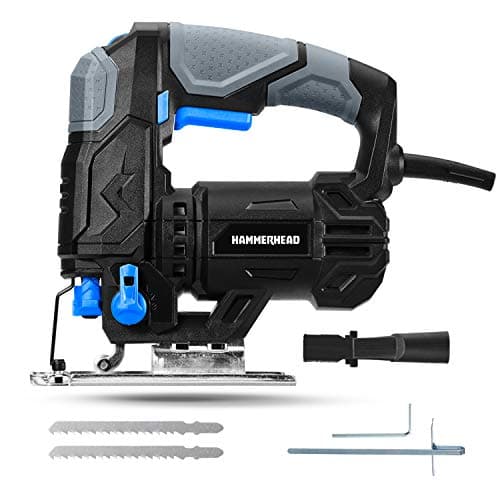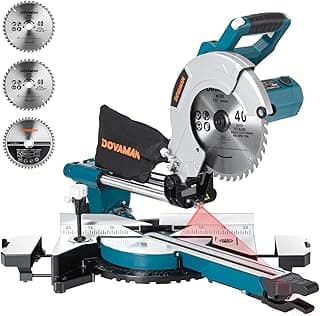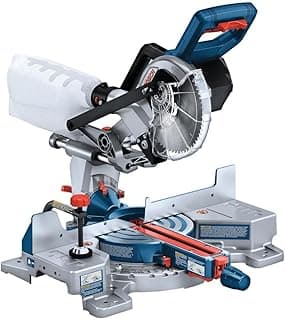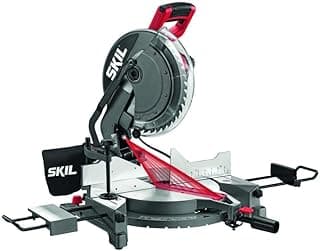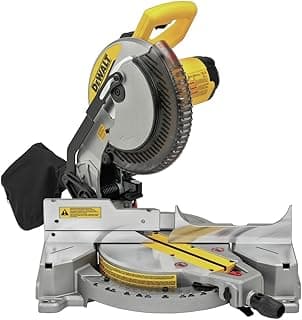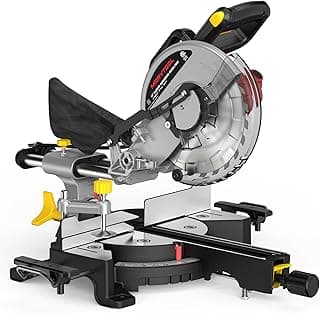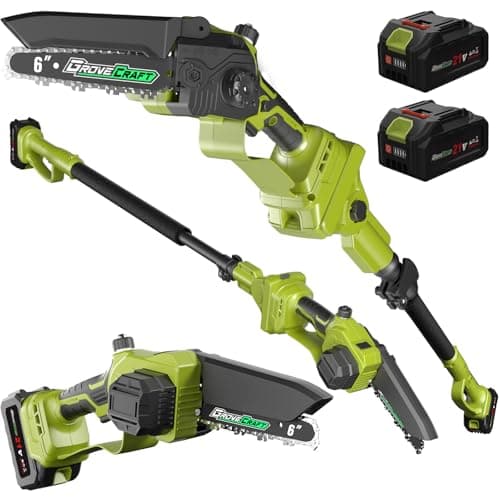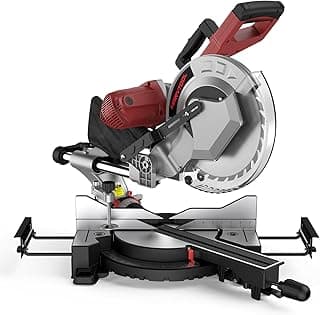When precision meets power, a jigsaw becomes one of the most versatile tools in any workshop. Whether you’re crafting fine curves, cutting intricate shapes, or handling thicker stock, choosing the best jig saw ensures smooth, controlled results every time. But here’s the catch—how do you know which one truly delivers?
In this review, we’ll break down everything that makes a jigsaw exceptional. From features to performance, you’ll learn how to select the right tool for your needs. And if you’re diving into specialty projects, you might also want to explore the best jig saws for woodworking, the best tenoning jig for table saw, or even the best cordless jig saws for added flexibility. Ready to see which model stands out? Let’s get started.
Top Picks
Best Precision Cutting: Cordless Jigsaw Compatible with Dewalt 20V Max Battery
The Bandeiman cordless jigsaw combines performance and versatility for both DIY users and professionals. Its brushless motor delivers up to 2,900 RPM, providing consistent power and longer runtime without overheating. The four orbital settings give users precise control over cut aggressiveness, making it suitable for everything from fine woodworking to tougher metal and PVC projects. The ±45° bevel cutting capability allows angled cuts with accuracy, guided by a laser-etched plate. Quick, tool-free blade changes and six included blades enhance efficiency across different materials. Added features like an LED light and dust blower improve visibility, while the ergonomic rubber grip and safety lock boost comfort and protection during extended use.
From a user perspective, this jigsaw offers impressive value through its smooth operation and clean results. Many appreciate the brushless motor’s durability and the convenience of blade changes without tools. The LED illumination is particularly helpful in dim areas. However, some users may find it inconvenient that the tool doesn’t include a battery, requiring additional purchase if they don’t already own compatible Dewalt 20V Max units. Overall, it’s a reliable and precise cutting tool for those seeking performance and control in a cordless design.
Best Control & Precision: DEWALT 20V MAX XR Jig Saw, 3,200 Blade Speed, Cordless
The DEWALT cordless jigsaw stands out for its precision engineering and reliable performance. Equipped with a brushless motor, it delivers longer runtime and improved efficiency compared to earlier models. Its compact design ensures a comfortable grip and superior control, making it ideal for detailed work in metal and other materials. The variable speed trigger and dial allow users to fine-tune cutting speed to match the task, while the 4-position orbital action provides versatility between smooth and aggressive cuts. The all-metal, lever-action blade clamp enables fast, tool-free blade changes, and the integrated dust blower keeps the cutting path clear. The bright LED light is a practical addition for working in low-light environments.
From the customer’s perspective, this jigsaw earns praise for its balance of power, control, and ease of use. Users appreciate how smoothly it handles both delicate and demanding jobs, with minimal vibration and consistent accuracy. The quick blade change system and ergonomic design add to its convenience. However, it may not be the top choice for extremely thick or industrial materials, as its compact frame prioritizes precision over raw cutting depth. Overall, it’s a dependable choice for professionals and serious DIYers who value accuracy and comfort in a cordless design.
Best All-in-One Kit: Dong Cheng 20V Brushless Jigsaw, 26mm Stroke, 800-3500 SPM
The Dong Cheng cordless jigsaw offers a strong balance of power, precision, and convenience for both professionals and DIY enthusiasts. Its high-efficiency brushless motor delivers stable performance across multiple materials, handling cuts up to 120mm in wood, 20mm in aluminum, and 10mm in steel. With a 26mm stroke length and variable speed range from 800 to 3500 SPM, users can easily adjust cutting speed for different materials and thicknesses. The 4 orbital-action settings enhance cutting efficiency, while the 0–45° adjustable bevel allows for accurate angled cuts on trim and framing tasks.
In real use, buyers appreciate its thoughtful design, which includes dual LED lights and a dust blower that maintain clear visibility during cutting. The tool-less blade change saves time between tasks, and the ergonomic D-shaped handle ensures steady control with reduced fatigue. The inclusion of a 4Ah battery, charger, six blades, guide rail, and tool bag makes it a complete, ready-to-use set—rare at this price point. Some users note that it feels slightly heavier than other cordless models, but the added stability often improves accuracy. Overall, this jigsaw is a versatile, feature-rich option for those who want a durable, well-equipped cutting tool.
FAQs
What’s Better Than a Jig Saw?
It depends on the job. For curved or intricate cuts, few tools outperform a jigsaw. However, if you need perfectly straight cuts through thick lumber or sheet materials, a circular saw or track saw often delivers cleaner results. Band saws are also superior for cutting thicker stock or continuous curves, especially when precision and power are equally critical.
Essentially, a jigsaw shines in versatility and maneuverability, while other saws excel in specific cutting applications. So, instead of replacing your jigsaw, think of it as part of a complete cutting toolkit.
What Is a Jig Saw Best Used For?
A jigsaw is best used for making curved, intricate, or plunge cuts in materials like wood, plastic, laminate, and even metal. Its narrow, reciprocating blade allows you to create patterns, circles, and detailed shapes that other saws can’t easily achieve.
Woodworkers often use it for decorative designs, while contractors rely on it for cutting openings in countertops or flooring. With the right blade, you can even handle tasks like trimming PVC pipe or slicing through sheet metal. It’s the go-to tool when flexibility and control matter more than raw power.
Can a Jigsaw Cut a 4x4?
Technically, most jigsaws are not designed to cut through a full 4x4 (which measures about 3.5 inches thick). The standard jigsaw blade length—typically around 4 inches—doesn’t provide enough depth to complete the cut efficiently or accurately.
You might manage to cut partway through from one side, then flip the wood and finish from the other, but alignment issues can cause uneven results. For this reason, it’s better to use a circular saw or reciprocating saw when working with thick lumber like 4x4 posts.
What Is the Lifespan of a Jigsaw?
A well-maintained jigsaw can last anywhere from 5 to 10 years—or even longer—depending on usage frequency and build quality. Professional-grade models tend to have longer lifespans due to superior components and better dust protection.
To extend its life, keep the tool clean, replace worn blades promptly, and avoid overloading the motor. Lubricate moving parts periodically, and store it in a dry, dust-free environment. Regular maintenance ensures consistent performance and keeps your jigsaw cutting smoothly for years.
Final Thoughts
A jigsaw is an essential tool for anyone who values versatility, precision, and control. Whether you’re cutting intricate designs, shaping materials for cabinetry, or tackling creative woodworking projects, the best jig saw can handle it all with ease.
By understanding what a jigsaw does best—and its limitations—you can make smarter tool choices for every project. Invest in a high-quality model, maintain it properly, and it will serve as a reliable partner in your workshop for years to come.

